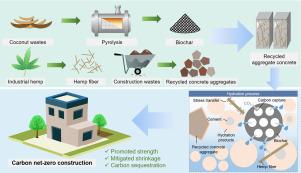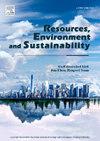从废物到价值:生物炭和大麻纤维协同碳封存和耐用的再生骨料混凝土
IF 7.8
Q1 ENVIRONMENTAL SCIENCES
引用次数: 0
摘要
再生骨料混凝土容易出现显著的干燥收缩,这阻碍了其更广泛的采用和建筑和拆除废物的可持续回收。本研究提出了一种新的内部固化策略,使用活性椰子生物炭(10%-30%)和大麻纤维(10-30毫米)同时解决收缩和强度缺陷。实验结果表明,与单独使用小颗粒或大颗粒生物炭相比,混合尺寸的生物炭改善了混凝土的新鲜和硬化性能。值得注意的是,虽然生物炭的掺入由于吸水和颗粒间摩擦的增加而降低了流动性,但由于基质致密化和纤维桥接效应,随着生物炭含量和纤维长度的增加,抗弯和抗压强度分别提高了34%和28%。生物炭和大麻纤维之间的协同作用通过降低硬化过程中局部水灰比促进水泥内部固化,并通过内部固化和成核作用促进水泥水化。尽管在干燥收缩的快速早期阶段增加,生物炭和大麻纤维的组合添加最终实现了显著的减少高达96%。此外,增加生物炭用量和纤维长度可提高基质密实度,大幅降低吸水率。这反过来又通过阻碍离子传输途径提高了对氯离子渗透的抵抗力。30%生物炭和30mm长的大麻纤维改性混凝土具有显著的碳减排潜力,在压缩情况下减少4.4 kg CO2当量/m3/MPa,在弯曲情况下减少23.8 kg CO2当量/m3/MPa。总的来说,这项研究促进了对收缩减缓机制的理解,并为高性能、低碳再生骨料混凝土的发展提供了一条可扩展的途径。本文章由计算机程序翻译,如有差异,请以英文原文为准。

From waste to worth: Biochar and hemp fiber synergy for carbon-sequestering and durable recycled aggregate concrete
Recycled aggregate concrete is prone to significant drying shrinkage, which hinders its broader adoption and the sustainable recycling of construction and demolition waste. This study presents a novel internal curing strategy using activated coconut biochar (10%–30%) and hemp fiber (10–30 mm) to simultaneously address shrinkage and strength deficits. Experimental findings demonstrate that mix-sized biochar improves both the fresh and hardened properties of the concrete when compared to using small or large biochar particles alone. Notably, while the incorporation of biochar reduces fluidity due to water absorption and increased inter-particle friction, both flexural and compressive strengths were enhanced – by up to 34% and 28%, respectively – with increasing biochar content and fiber length, as a result of matrix densification and fiber-bridging effects. The synergy between biochar and hemp fibers facilitates internal curing by lowering the local water–cement ratio during hardening and promoting cement hydration through both internal curing and nucleation effects. Despite a rapid early-stage increase in drying shrinkage, the combined addition of biochar and hemp fiber ultimately achieves a remarkable reduction of up to 96%. Furthermore, increasing biochar dosage and fiber length enhances matrix compactness, substantially reducing water absorption. This, in turn, improves resistance to chloride penetration by obstructing ion transport pathways. Concrete modified with 30% biochar and 30 mm-long hemp fibers demonstrates significant potential for carbon emission reduction, achieving decreases of 4.4 kg CO2 eq./m3/MPa in compressive scenario and 23.8 kg CO2 eq./m3/MPa in flexural scenario. Overall, this study advances the understanding of shrinkage mitigation mechanisms and offers a scalable pathway for the development of high-performance, low-carbon recycled aggregate concrete.
求助全文
通过发布文献求助,成功后即可免费获取论文全文。
去求助
来源期刊

Resources Environment and Sustainability
Environmental Science-Environmental Science (miscellaneous)
CiteScore
15.10
自引率
0.00%
发文量
41
审稿时长
33 days
 求助内容:
求助内容: 应助结果提醒方式:
应助结果提醒方式:


